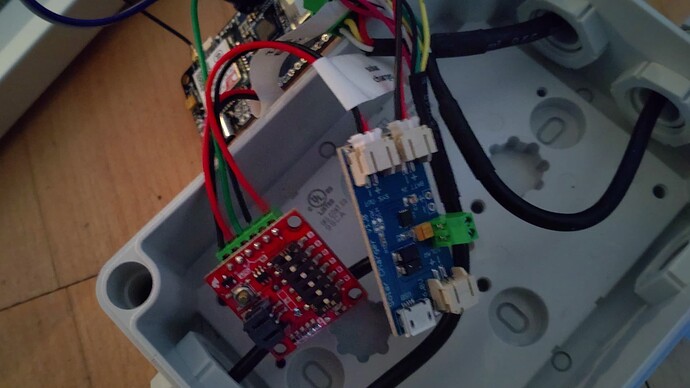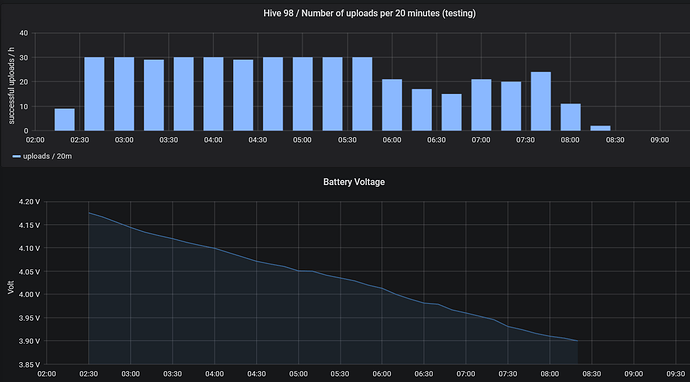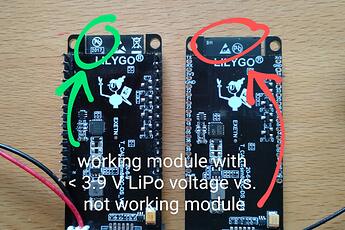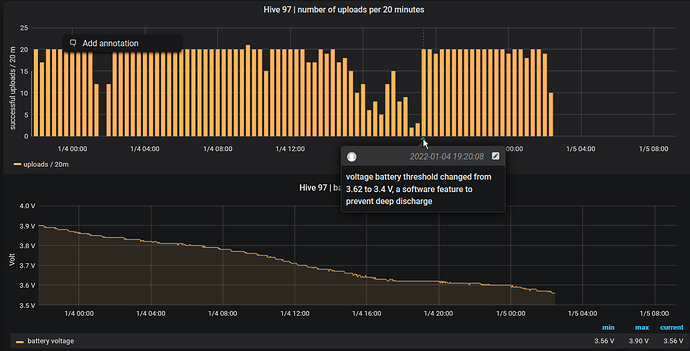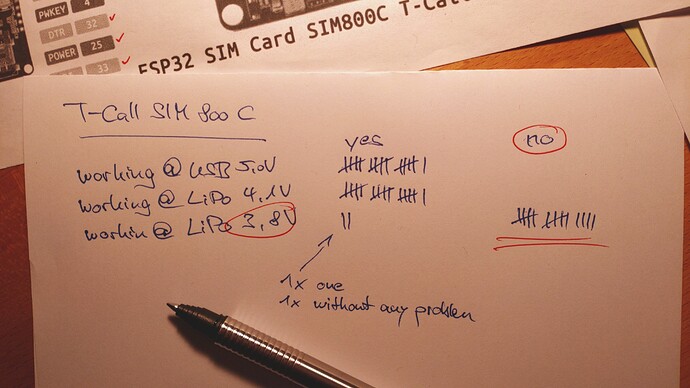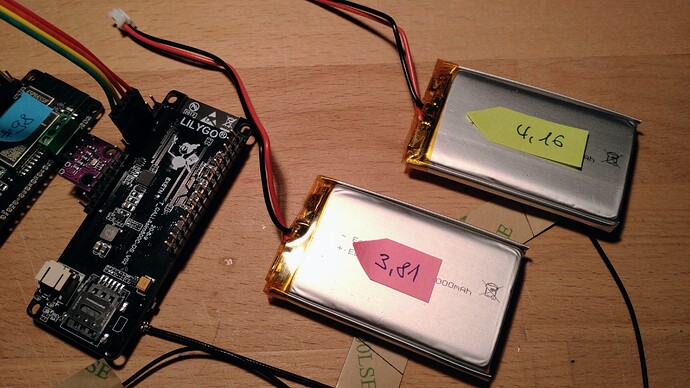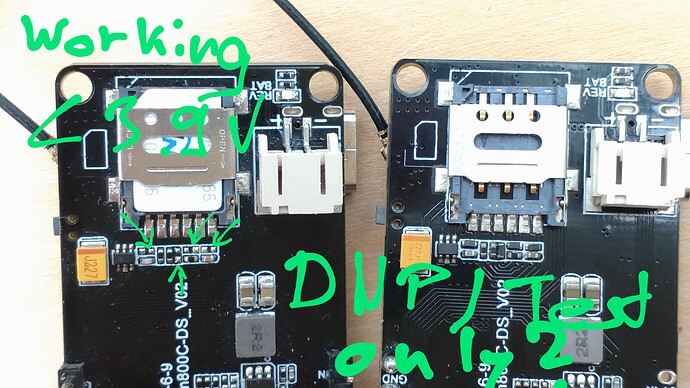Noch ein paar Tests zur den Schwierigkeiten mit dem SIM800-Modul des TTGO T-Call SIM800C in Zusammenhang mit der Stromversorgung:
- Test ohne TPL5110-Timer nur:
LiPo / Solarpanel > CN3065-Solar-Charger-Platine > T-Call
- Test mit 2000 mAh-Akku von Eckstein
- testweise und um den Akku leerzusaugen Datenübertragung alle 40 Sekunden
Testdurchlauf 1, ca. 340 Datensätze, 4,19 V bis 3,87 V
Testdurchlauf 2, anderer LiPo, aber gleiches Modell, ca. 430 Datensätze, 4,18 V bis 3,90 V
- Geht “gut” nur bis ca. 4,0 V Akku-Spannung.
- Über 4,0 V ist alles fein: Wenn alle 40 s Daten gesendet werden, sind in 20 m bis zu 30 uploads möglich, die sieht man oben in der Grafik (20m x 60s / 40 s = 30 uploads).
- Unter 4,0 V werden deutlich weniger Verbindungsversuche korrekt abgeschlossen, ggf. dauert der Verbindungsaufbau auch “nur” länger und daher werden in Summe weniger Daten übertragen. Oben sind es ca. 2/3 weniger Datensätze die ankommen bei Testdurchlauf 1, mit einem anderen LiPo (gleuches Modell) sind es im Durchlauf 2 ca. 1/3 weniger erfolgreicher uploads.
- Bereits bei ~3,9 V wird gar keine GPRS-Verbindnung mehr erfolgreich aufgebaut. :-(
[edit1] Testdurchlauf 3, nochmal LiPo aufgelanden, upload jetzt alle 4 Minuten, ca. 260 Datensätze, 4,18 V bis 3,93 V
Auch im Durchlauf 3 mit jetzt 4 Minuten Zeit zwischen den uploads hat das Modul Schwierigkeiten bei LiPo-Spannungen unter 4 V, und das obwohl die LiPos eigentlich mit 3,7 V spezifiziert sind, da geht aber gar nichts mehr bei 3,7 V. Der ESP funktioniert aber noch und führt Messungen durch und versucht auch jetzt noch, ca. 20 Uhr (der letzte erfolgreiche upload war um 16 Uhr) Daten zu senden, bekommt die Verbindung aber nicht hin.
[edit2/3] Nun nochmal andere T-Call-Board getestet: Bei einigen werden auch Daten übertragen / funktionieren bei LiPo-Spannungen unter 3,9 V, andere nicht. Was für ein …! Hier nochmal Details dazu:
Siehe auch Some T-Call-SIM800C do not work below 3.9 V LiPo voltage · Issue #189 · Xinyuan-LilyGO/LilyGo-T-Call-SIM800 · GitHub.
The working module with voltage below 3.9 V is a T-Call I ordered a time ago, it has a different silkscreen at the ESP32 module as you can see on the left side. The not working module is on the right side, I ordered them 2021-11-18 via Lilygo’s AliExpress shop:
Here are ongoing test with the older T-Call SIM800C (left side on the pic in the last posting). I connected the discharged LiPo with ~3.9 V to this board and could send around 1470 additional datasets down to 3.56 V (measured by the AXP).
While testing I had to change my software - you can see the time at the blue triangle - I had a very conservative threshold definde to prevent LiPo from deep discharge - and after setting this to a lower limit the T-Call could send data down to to 3.56 V!
That means that it was possible to send 1800 datasets with a LiPo form 4.2 to 3.5 V with one T-Call vs. 400 datasets only with a newer T-Call and a Lipo form 4.2 to 3.9 V. What was changed in the meantime? Why do the other T-Call stop working at 3.9 V? Why is this change in hardware not reflected by the silkscren number or note? In case there was no hardware change (I can not imagine) is there any setting in the AXP chip that is not overwritten by uploading new software and we can and should change?
The older T-Call is really working good but what a mess with the newer / other one! Any suggestin what I can do to get the modules working down to 3.5 V?
[edit4] I have spent a hour to test all 16 T-Call SIM800C boards I have laying around at my workbench.
- all 16 working via SIM800 with USB-Power
- all 16 working via LiPo with ~4.1 V
- 14 do not work via LiPo with ~3.8 V
- 2 are working via LiPo with ~3.8 V, but one T-Call only one time, so its more ore less 1 board with no problem and working with voltage below 3.9 V
The working board is the one on the left side in posting #2 in this thread. As far as I can reconstruct it is an “older” T-Call SIM800C, I have ordered Mar., 28th 2021 via LilyGo’s AliExpress shop.
The non working T-Calls with SIM800C are ordered Nov., 18th 2021 via LilyGo’s AliExpress and some board from your reseller Eckstein, I have ordered September 2021 in Germany.
For testing the 16 boards I have used a 2000 mAh LiPo from Eckstein, see https://eckstein-shop.de/LiPoAkkuLithium-IonPolymerBatterie32C7V2000mAhJST-PHConnector but I have tested some other LiPos (one from Adafruit, 2200 mAh and one from SODAQ, 1200 mAh) with the same outcome. I have also tested with a power bench supply, same issue! So the problem is not the LiPo!
Still the question was anything changed in production / in the board design. Or can you imagine that some settings of the AXP are by default different at this different production runs? I just want to know: Can I something do against this miss-function via software or is it a hardware bug.
[edit5] I had a detailed look at the two boards the working one is the on the left side vs. the not working! I found some not populated parts at the working board! So on the working bord the parts are “missing” or not placed.
I have sacrified one board and tried to desolder this parts but made some collateral damage, my skills and equipment is not sufficient for this small structures.
Could this be the reason for the different behaviour? Are this parts ment to be placed or DNP parts and they should not be on the board?
[edit6] Der LilyGo-Support ist leider ziemlich unfähig und emfiehlt per E-Mail eine Sromquelle, die out of spech ist:
Bei 18.57€ |LILYGO® T Call & SIM800C ESP32 WROVER WIFI Bluetooth Wireless Modul Nano SIM Karte Slot Entwicklung Schaltungen Bord Hardware|Schaltungen| - AliExpress steht unter Power Supply Specifications
Battery 3.7V lithium battery
Da der T-Call einen charger-chip hat kann es allerdings keine Primärzelle (nicht wiederaufladbar) sein, sonder muss ein LiPo sein! Der “Technische Support” schreibt nun:
The instantaneous current peak of SIM800C is as high as 2A. To make sure the current is enough. Lithium batteries larger than 4.2V are recommended. To ensure enough current.
Was für ein Quatsch! Da investiert man Stunden um deren Fehler einzugrenzen und wird dann nur mit Schrott abgespeißt was irgend ein Hiwi aus dem Internet als vermeintliche Lösung rausgesucht hat.


